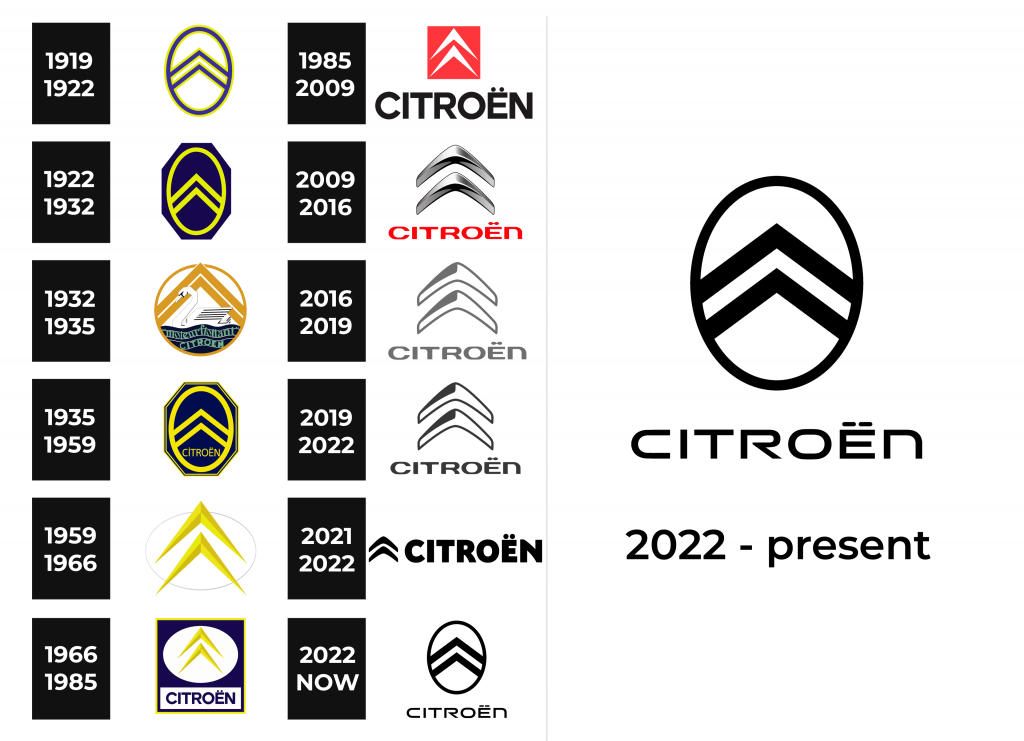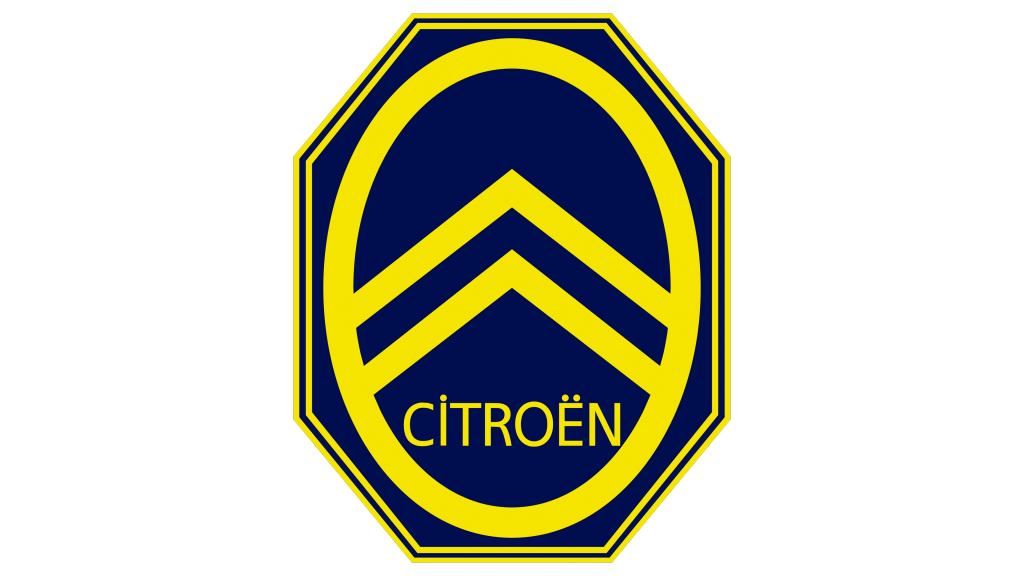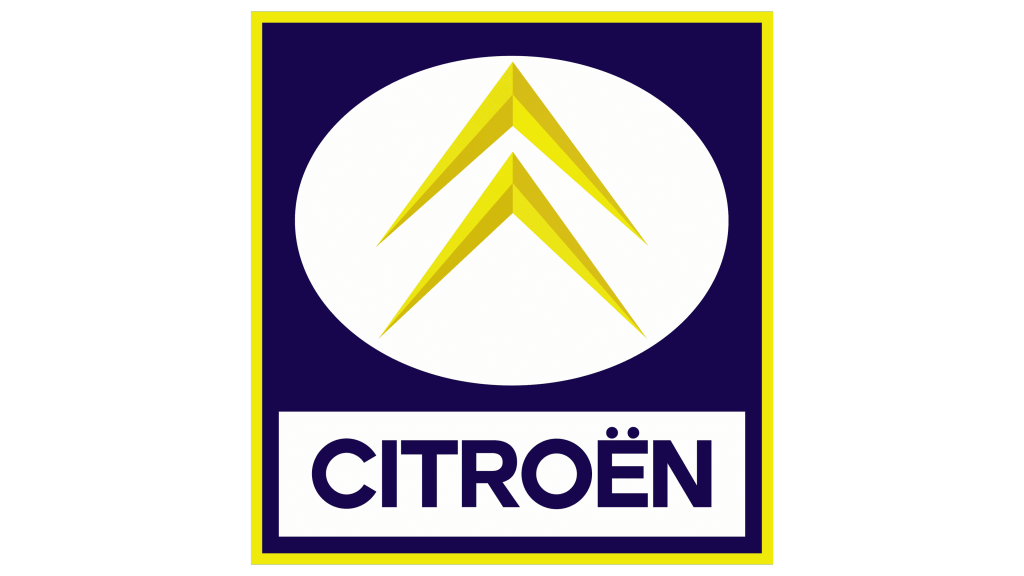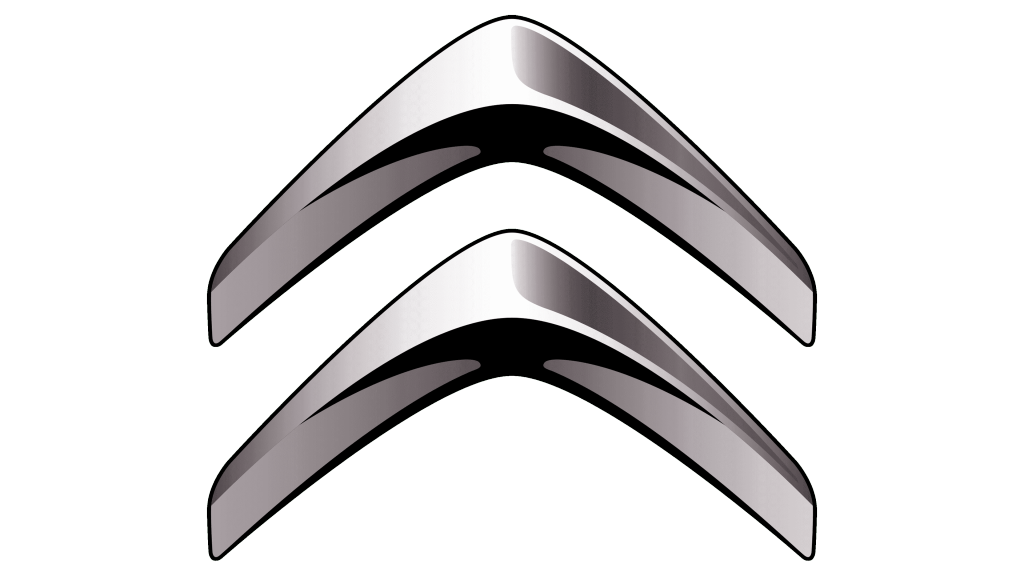Citroën Logo
Tags: Black Car Brands | cars that start with c | France cars
The transformation of André Citroën’s mechanical and military equipment industry led to the birth of the French car manufacturer which today belongs to the PSA group (which also includes Peugeot) known to all as Citroën.
Meaning and History
The evolution of the Double Chevron symbol has been constant throughout the 101-year history of the French company: the 2 arrowheads pointing upwards that have always distinguished it, date back to 1919, the year in which André Citroën launches into the automotive sector.
1919 – 1922
But the history of the symbol depicted in the logo dates back to 1900, that is the year when Citroën acquired a patent in Poland. From this adventure, the double chevrons have always been depicted in the logo of the French company. Specifically, from 1919 to 1921 they were yellow chevrons on a blue background.
1922 – 1932
The first evolution of the Citroën logo begins early, that is already in 1921: the new symbol is an oval positioned on the blue hexagonal background to emphasize the yellow chevrons.
1932 – 1935
In those years, the Rosalie cars were the first with the new floating engines, and for this reason they were embellished with a second emblem: it was a swan that swam among the Citroën chevrons, and appeared directly on the front of these models.
1935 – 1959
The 1928-1949 logo was similar to the 1922-1928 logo, only instead of the oval there was now a circle, and the Citroën lettering was added.
1959 – 1966
The years pass, and the logo continues its history parallel: it is 1959 when the golden chevrons are superimposed on the white ellipse.
1966 – 1985
Years later, these symbols are placed in a new blue square with the Citroën lettering.
1985 – 2009
The eighties were dynamic years, and in 1985 another logo was born, which thanks to the new colors (red and white) modernized the image of the French company. The double angle radically changed design and appeared in white in front of a red square while keeping the same font.
2009 – 2016
This novelty continues until modern times: in fact, 2009 is the year in which Citroën chooses to present a new logo again. This time the chevrons are in 3 dimensions, chromed and accompanied by the Citroën lettering in red.
2016 – 2019
Today’s logo was born in 2016 and represents the latest (to date) evolution: the novelty lies in the use of two-dimensional and is inspired by flat design, with the aim of being linear and easily identifiable by all.
2019 – 2022

The company kept improving its logo. This time, it made all the gray elements black. The darker color gave the emblem a stronger and more confident look, plus it was easier to see on any background. At the same time, black is not very unique, but rather a classic choice.
2021 – 2022

The name of the brand was made the main element of the logo. It was printed in bold, uppercase letters using a font similar to Noah Grotesque Black by Fontfabric but with the diagonal stroke of the “N” and the leg of the “R” being slightly curved. The inscription was accompanied by black chevrons on the left, which were sized to be the same height as the letters. The logo turned out grand but was used only for a little over a year.
2022 – Today
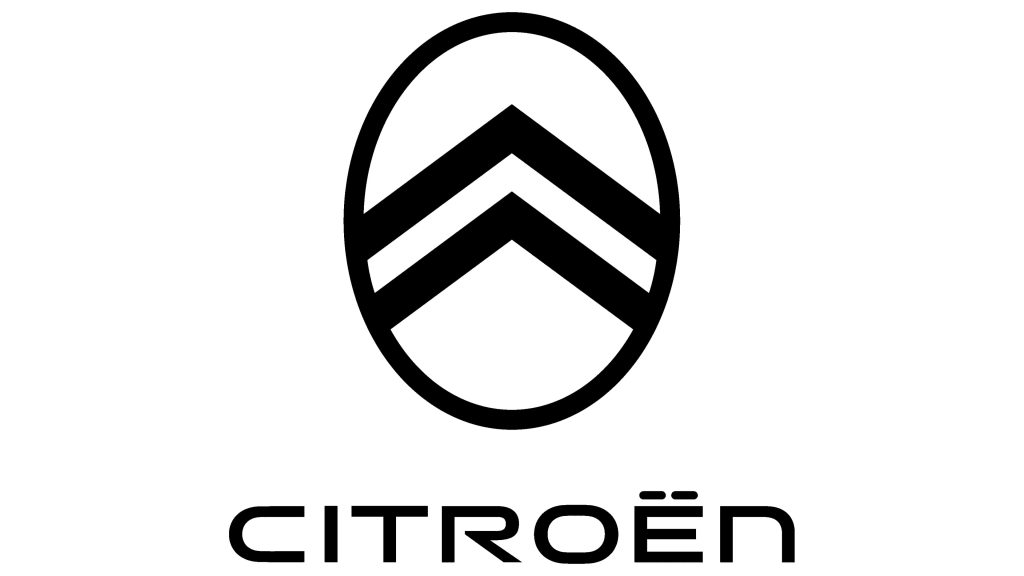
The updated design combined several versions into one stylish look. First of all, the new font looked more like what the company used from 2009 until 2022, partially due to the use of a lowercase “N”. However, the font had some kind of edginess to it and reflected that the company is developing and keeping its hand on the latest innovations. Above, there was a relatively large oval shape with chevrons. The latter featured straight lines of the same thickness that created a sharp, pointed angle. In fact, there was a lot of resemblance between the logo seen a little over a century ago and this one. This was a great move to show that the company has been standing strong for more than a century and be trusted and relied on.
The Legends
Citroën DS
Along with the 2CV, it is the most famous Citroën in the world. He surprised everyone at the Paris Motor Show in 1955 with a very streamlined and modern body. It looked completely different from the previously produced box-shaped cars with a high radiator grille.
Citroën 2CV
The popular “Duck” is the car that motorized France. Its prototype (called “Very Small Car”) was unveiled before the war, but the serial version did not make its debut in 1948. The assumptions of the 2CV project were simple – the car was supposed to accelerate to 60 km/h, accommodate four passengers and 50 kg of luggage.
Citroën CX
This highly aerodynamic body model was Citroën’s most exclusive car, so it was equipped with state-of-the-art technology – hydropneumatic suspension, variable power steering and a futuristic dashboard with drum gauges. It was powered by gasoline and diesel engines, including turbodiesels.
Citroën GS
During its debut, it was said that the GS was to be a combination of the concepts of the 2CV (practical and affordable) and DS (extensive equipment and high driving comfort) models. And it happened, because the GS turned out to be very popular – 1.9 million units were sold.
The Concept Cars
Citroën Ami One concept
The prototype, shown in 2019, is intended to provide freedom of travel, as the 2CV once did. It is small so it can be interesting for people who travel around the city by metro or scooter. It is also fully autonomous, which means that even people without a driving license can drive it.
Citroën Tubik
The unusual styling of the vehicle resembles the pre-war TUB delivery van and the post-war Citroën H. It is not, however, intended to carry goods, but to provide a new dimension of travel. In Tubik, there is a place for the driver separated by a special capsule, and the rest of the interior looks like a living room, the space of which can be freely configured, e.g. by unfolding a large bed.
Citroen GT
It was probably the first concept car that was created on the occasion of the premiere of a computer racing game, namely “Gran Turismo 5”. It was a fully mobile prototype powered by a 789hp gasoline engine. It accelerated to 330 km/h, and the first 100 km/h it reached in 3.6 seconds. It was designed by Takumi Yamamoto from Jean Pierre Ploue studio, and the interior was created by Louis Vuitton.
Race Cars
Citroen Xsara Rally Car
The Citroen Xsara Rally Car performed brilliantly at the 1999 World Rally Championship. Despite belonging to the non-prestigious F2 class (Kit Car), it won a convincing victory and was able to surpass the rivals in higher categories.
Citroen C4 WRC
In 2005, Citroen stopped participating in the WRC (World Rally Championship), and by 2007 Citroen entered the tournament with a new car that replaced the Xsara – the Citroen C4 WRC that had a new EW engine and improved aerodynamic characteristics.

